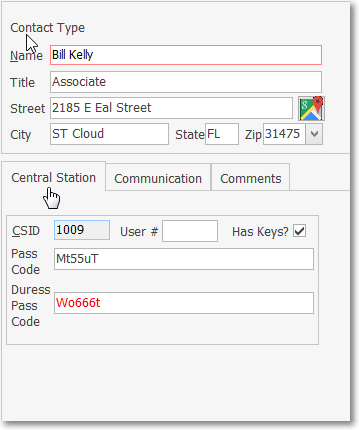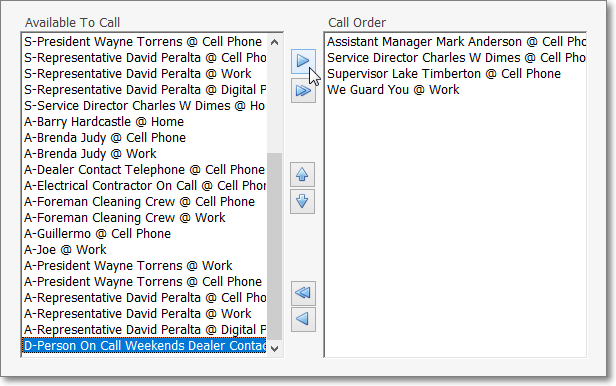❑The Conditions Call tab - available for a each CSID listed on the Subscriber Panels section of the Central Station Data section of the Monitoring tab in the Edit View of the Subscribers Form - allows a User to identify an Alarm Condition Code which - when sent by the Selected Subscriber Panel CSID - will utilize a customized Contacts (People To Call) List ("Contacts") previously defined as such in the CSID Zone record that has the special combination of Signal ID and Panel Zone defined there.
•That Designated List of Contacts will be used for Notification purposes when processing a specified Condition Code for any Alarm Signal that was assigned that Alarm Condition Code
•This Conditions Call feature will then be used whenever a specific Alarm Condition requires a specific (e.g., one of a kind) Notification Sequence be used by the Operator when processing that Alarm Condition for that Subscriber.
•The Why?
✓A Subscriber may have many Alarm Signals (multiple Signal Identifier and/or Panel Zone combinations) defined that are all assigned the same Condition Code and each of those Alarm Signals requires that the same special calling order (i.e., Notification Sequence) of a specifically defined list of Contact s be used for Notification purposes.
▪When every Alarm Signal with that same Alarm Condition Code requires the use of the same customized set of Contacts:
oInstead of entering this customized Contacts List many, many times (for each Signal Identifier and/or Panel Zone combination for that CSID that is assigned this Condition Code),
oDefine one customized Contacts List and Notification Sequence.
✓The clear benefit of maintaining one customized Contacts List for a CSID based on a specific Alarm Condition Code is:
a.It will make data entry faster, and more accurate.
b.Data maintenance for the contents or calling order of those Contacts - when changes are required - will be much easier to make.
c.Customized Contact List will be more reliable and so ultimately the Response by the Operator will be consistently accurate.
i.This is because the List of Contacts associated with a specific Alarm Condition Code - and the individual Telephone Numbers within that List of Contacts - will invariably need to be updated/changed - often.
ii.If each change had to be done many times in many CSID Zone records (for every case where that Alarm Condition Code was used), data entry errors would - not might, but would - occur.
➢Note: To learn about another way to create a set of special purpose Contacts, see the Contact Lists chapter
•The How? An Overview of the steps required:
a)Identify the Alarm Condition Code for which a customized Contacts (People To Call) Notification Sequence will be required for the Subscriber's CSID
b)Identify those individual Contacts which will need to be Notified (add them in the Subscriber's Contact (People To Call) Form, if necessary).
c)Determine the sequence in which they are to be notified (when this specific Alarm Condition Code is received from that Subscriber's CSID).
1.To identify the Alarm Condition Code(s) for which a customized Contacts List will be required for the currently selected Subscriber CSID:
▪In the the Subscriber Panels section of the Central Station Data Form, Select the appropriate CSID.
▪Locate and Click the Conditions Call tab.

Subscriber Panels section - Conditions Call tab
▪The Conditions Call dialog will be displayed.
oAdd - Click the ![]() Icon to create a new record.
Icon to create a new record.
oCondition - Using the Drop-Down Selection List provided, Choose the appropriate Alarm Condition Code.
> In the example above the "CO" f)or Carbon Monoxide) Alarm Condition Code was used
oSignal ID - "Invent" and enter a Signal Identifier that represents the Selected Alarm Condition Code.
> In the example above the "GAS" Signal Id was invented, but any character string may be utilized.
> Keep in mind that a Signal ID can have no more that five (5) characters.
> Make sure that the "invented" Signal Identifier does not duplicate an actual Signal Identifier.
> If in doubt, examine the list of Signal Identifiers for the Communicator Format assigned to this CSID in the Panel Info tab
oPhysical Zone - "Invent" and enter a Physical Zone that represents the Selected Alarm Condition Code.
> Keep in mind that a Physical Zone can have no more that five (5) characters.
> Make sure that the "invented" Physical Zone does not duplicate a real Panel Zone.
oSave - Click the ![]() Icon to save the entry.
Icon to save the entry.
2.Confirm that the Contacts (People To Call) individuals and Contact information required for this Alarm Condition Code have been defined, and if not, enter them now.
▪In the Subscriber Panels section:
▪Select the appropriate CSID.
▪Click the Contacts (People To Call) tab.

Contacts (People To Call) Form
▪Within the Central Station tab on the Contacts (People To Call) Form,
oEnter any new User and/or Pass Code Information as may be required

Contacts (People To Call) Form - Central Station sub-tab
oEnter the required Telephone Numbers in the Call Numbers section on the Contacts (People To Call) Form.
3.Define a customized Contacts (People To Call) Notification Sequence, using the CSID Zones Form to create a new record with the "invented" Signal ID and Physical Zone set:
▪In the the Subscriber Panels section:
▪Select the appropriate Contacts (People To Call).
▪Click the CSID Zones tab and select the Zones tab

CSID Zones Form - with customized set of People To Call for one Condition Code
▪Enter the specialized CSID Zones record that will identify the customized Contacts (People To Call) List required for the specified Condition Code:
oAdd - Click Add ("+") to create a new record.
oSignal ID - Enter the Signal ID that corresponds to the one entered in the Conditions Call dialog for this Condition Code.
oPhysical Zone - Enter the Physical Zone that corresponds to the one entered in the Conditions Call dialog for this Condition Code.
oAlarm Code - Using the Drop-Down Selection List provided, Choose the Condition Code for the required customized Contacts (People To Call) List that corresponds to the one entered in the Conditions Call dialog for this Condition Code..
oOCTAR Code - Do not change the default Alarm entry.
oAvailable To Call - This Available To Call list of Contacts contains the Contacts (People To Call) associated with for the CSID for which this CSID Zone is created, plus any others Contacts available from the Global Call List members (see above), and represents the default order in which Operator Notifications should proceed until someone is successfully notified (see the "Available To Call" discussion in the CSID Zones chapter).

▪Call Order - This column is used to identify the customized Contacts (People To Call) List required for the specified Condition Code:
oSelect a Name from the Available To Call column and Click the right arrow ![]() to move that Name to the Call Order column.
to move that Name to the Call Order column.
oTo move all Names from the Available To Call column to the Call Order column Click the two-right-arrow cluster.![]()
oYou may move Names up and down the Call Order column by Selecting them, and then Clicking either the up or down arrow, as needed, to relocate then to the desired position.![]()
oSelect a Name from the Call Order column and Click the left arrow ![]() to move that Name to the Available To Call column.
to move that Name to the Available To Call column.
oTo move all Names from the Call Order column to the Available To Call column Click the two-left-arrow cluster.![]()
oNo other information is required.
oSave - Click the ![]() Icon to save the revised Notification Sequence.
Icon to save the revised Notification Sequence.
•The Result
✓When an Alarm Signal requiring a Response from an Operatoris is received at the Central Station:
1.The appropriate CSID Zone or a Panel Zone record is located for that Alarm Signal and its associated Condition Code is identified.
2.If that Subscriber Panel's CSID has one or more [ Condition Code plus Signal ID and Physical Zone combinations ] defined in the Call List Conditions dialog:
a.SPA will compare the Condition Code identified for that Alarm Signal with the Condition Code(s) defined in the Call List Conditions dialog.
b.If there is a Match, then the "invented" Signal ID and Physical Zone combination - defined with that Condition Code - will be located in their CSID Zones table.
c.SPA will then use the customized list of Contacts (People To Call) defined in that located CSID Zones record.
✓In summary, when the Condition Code identified for an Alarm Signal (using either a Panel Zone or a CSID Zone record) also matches a Condition Code entered in the Call List Conditions dialog, the "invented" Signal ID and Physical Zone combination - entered for that Condition Code in the Call List Conditions dialog - will be used to locate the special CSID Zone record containing the required customized list and Call Order of the Contacts (People To Call)